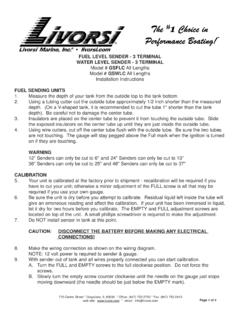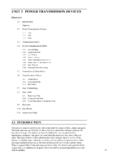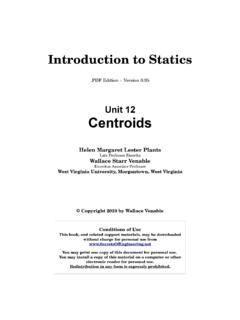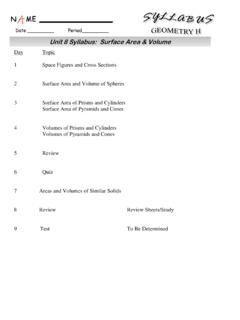Transcription of UNIT 62: STRENGTHS OF MATERIALS Unit code: K/601/1409 …
1 1 unit 62: STRENGTHS OF MATERIALS unit code : K/601/1409 QCF level: 5 Credit value: 15 OUTCOME 1 - TUTORIAL 1 COMPLEX STRESS AND STRAIN 1. Be able to determine the behavioural characteristics of engineering components subjected to complex loading systems Complex stress: analysis of two-dimensional stress systems determination of principal planes and stresses, use of Mohr s stress circle; combined torsion and thrust; combined torsion and bending Complex strain: Mohr s strain circle; experimental strain analysis using elecrical resistance strain gauges Theories of elastic failure: maximum principal stress theory.
2 Maximum shear stress theory strain energy theory and maximum principal strain theory You should judge your progress by completing the self assessment exercises. These may be sent for marking at a cost (see home page). CONTENTS 1. COMPLEX STRESS Derivation of Equations Determining the Principal Stresses and Planes Mohr's Circle of Stress 2. COMPLEX STRAIN Principal Strains Mohr's Circle of Strain Construction 3 STRAIN GAUGE ROSETTES Construction of the 45o Circle Construction of a 60o Rosette 4. COMBINED BENDING, TORSION AND AXIAL LOADING. You will find a useful tool for solving Mohr circle programs at the link below but you should only use it for checking your solutions 2 1.
3 COMPLEX STRESS MATERIALS in a stressed component often have direct and shear stresses acting in two or more directions at the same time. This is a complex stress situation. The engineer must then find the maximum stress in the material . We will only consider stresses in two dimensions, x and y. The analysis leads on to a useful tool for solving complex stress problems called Mohr's' Circle of Stress. DERIVATION OF EQUATIONS Consider a rectangular part of the material . Stress x acts vertically and y acts horizontally. The shear stress acting on the plane on which x acts is x and y act on the plane on which y acts.
4 The shear stresses are complementary and so must have opposite rotation. We will take anticlockwise shear to be positive and clockwise as negative. Suppose we cut the material in half diagonally at angle as shown and replace the internal stresses in the material with applied stresses and . In this case we will do it for the bottom half. The dimensions are x, y and t as shown. Note in most modern derivations x is horizontal acting on the x plane and y is vertical acting on the y plane. This does not affect the derivation since all we have to do is rotate everything 90o to make it the same.
5 Figure 1 Now turn the stresses into force. If the material is t m thick normal to the paper then the areas are t x and t y on the edges and t y/sin or t x/cos on the sloping plane. The forces due to the direct stresses and shear stresses are stress x area and as shown. Figure 2 Figure 3 3 The material is in equilibrium so all the forces and moments on the plane must add up to zero. We now resolve these forces perpendicular and parallel to the plane. To make it easier the forces are labelled a, b, c, d, e, f, g, and h.
6 Figure 4 a = t y y sin . b = t y y cos c = t y y cos . d = t y y sin e = t x x sin f = t x x cos g = t x x cos h = t x x sin All the forces normal to the plane must add up to (t y/sin ) . Balancing we have a + c + e + g = (t y/sin ) All the forces parallel to the plane must add up to (t y/sin ) - f + h+ b - d = (t y/sin ) Making the substitutions and conducting algebraic process will yield the following results. 22cos222sin22sin22cos222cos122sin22sin22 cos1tancossintansin22sin22cos1cossinsinc ossinsincossincossinsin222 xxxyyyxxyyxxyyxyyxxyyyxyxtxtxtytyty Perhaps the point should have been made earlier that the shear stress on both planes are equal (read up complementary stress) so we denote them both xy = x = y 2sin22cos2xyyxyx.
7 ( ) Repeating the process for the shear stress we get 2cos22sinxyyx ..( ) 4 Consider the case where x=125 MPa, y=25 MPa and xy=100 MPa 2sin1002cos5075 2cos1002sin50 If the value of and are plotted against the resulting graphs are as shown below. Figure 5 In this example the maximum value of is about 190 MPa. The plane with this stress is at an angle of about 32o. The maximum shear stress is about 112 MPa on a plane at angle 77o. These general results are the same what ever the values of the applied stresses. The graphs show that has a maximum and minimum value and a mean value not usually zero.
8 These are called the PRINCIPAL STRESSES. The principal stresses occur on planes 90o apart. These planes are called the PRINCIPAL PLANES. The shear stress has an equal maximum and minimum value with a mean of zero. The max and min values are on planes 90o apart and 45o from the principal planes. This is of interest because brittle MATERIALS fail on these planes. For example, if a brittle material is broken in a tensile test, the fracture occurs on a plane at 45o to the direction of pull indicating that they fail in shear.
9 Further it can be seen that the principal planes have no shear stress so this is a definition of a principle plane. = 0 when = on the principal planes where it is maximum or minimum. There are several theories about why a material fails usually. The principle stresses and maximum shear stress are used in those theories. 5 DETERMINING THE PRINCIPAL STRESSES AND PLANES You could plot the graph and determine the values of interest as shown in the previous section but is convenient to calculate them directly. The stresses are a maximum or minimum on the principal planes so we may find these using max and min theory (the gradient of the function is zero at a max or min point).
10 First differentiate the function and equate to zero. 2sin2cos202cos22sinyxyxdd yx ( ) There are two solutions to this equation giving answers less than 360o and they differ by 90o. From this the angle of the principal plane may be found. If this angle is substituted into equation ( ) and algebraic manipulation conducted the stress values are then the principal stresses and are found to be given as 242221maxxyyxyx ..( ) 242222minxyyxyx ..( ) Repeating the process for equation ( ), we get 2242122max ( ) 2242122min ( ) WORKED EXAMPLE No. 1 Using the formulae, find the principal stresses for the case shown below and the position of the principal plane.


















